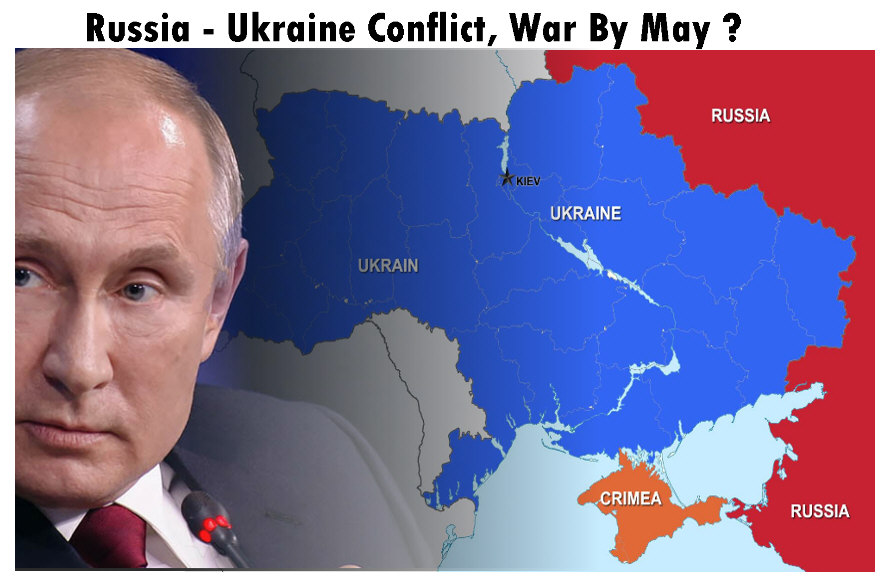
Russia – Ukraine “War in a month … in early May? Everything will be ready,”. Putin suddenly began massing troops on the Ukrainian border last week. He also sent four warships from his Baltic Sea fleet through the English Channel to reinforce units in the Black Sea.
“A shock tank brigade ready to break through” from Russia-occupied Crimea in southern Ukraine.
And it covertly controls two divisions – the ‘Donbas People’s Militia’ and ‘Luhansk People’s Militia’ – in Russia-occupied east Ukraine.
The maneuvering comes amid a spike in lethal violence on the east-Ukrainian contact line, creating pretexts for intervention.
“According to our intelligence assessment, Russia is preparing deployment of regular units of the armed forces of the Russian Federation [in east Ukraine], citing the need to protect Russian citizens there”, Ukraine’s EU ambassador, Mykola Tochytskyi,
Increasing volatility on the front line in Eastern Ukraine dates back to at least the end of January when the Organization for Security and Co-operation in Europe (OSCE) recorded rising numbers of ceasefire violations. But it wasn’t until late March that this began to make international headlines.
In one of the bloodiest incidents, four Ukrainian servicemen were killed March 26 in the Donetsk Region — the Ukrainian side blamed this on a mortar attack by the forces of the self-proclaimed Donetsk People’s Republic (DNR). Four days later, Ruslan Khomchak, commander-in-chief of Ukraine’s armed forces, said Russia was building up its military presence on the country’s borders. Since mid-March, the Russian military has conducted at least three training exercises on the Ukrainian border, according to independent media outlet Meduza.
There are different estimates for the size of the Russian force on the Ukrainian border. Khomchak spoke of 28 battalions, which would mean about 22,000 soldiers. However, a United State military source cited in the New York Times gave a much lower number – 4,000 soldiers. A White House spokesman said Thursday that Russia had more troops at the border than at any point since 2014. And some observers have noted the presence of Russian Iskander missile systems among the military units near the border.
President Vladimir Putin’s spokesperson, Dmitry Peskov, did not dispute the fact of a military build-up, saying that Russia “moves its armed forces around its territory at its discretion”.
At the same time, the number of ceasefire violations are rising: in its daily report last Sunday, the OSCE noted incidents were up tenfold in Luhansk Region. Ukrainian Deputy Prime Minister Oleksii Reznikov announced Tuesday that Ukrainian representatives would no longer be travelling to the Belarusian capital Minsk for scheduled three-way talks on the conflict.
Ukrainian President Volodymyr Zelensky visited the frontlines Thursday and spoke of a “big escalation”. Later that day, Dmitry Kozak, Russia’s lead negotiator on the conflict and deputy chief of staff of the presidential administration, made several saber-rattling statements. “If, as our president says, they are going to engineer another Srebrenica [referring to the massacre of Bosnians during the Yugoslav civil war in 1995, which has become a notorious example of ethnic cleansing – The Bell], clearly, we will need to defend them,” he said. “The start of a [possible] conflict is the beginning of the end for Ukraine,” Kozak added. “But if you stick to the agreements, the conflict can be resolved within a year.”
The West’s reaction
Since the end of March, Ukraine has been actively consulting with Washington. Senior Ukrainian officials have discussed the issue with the U.S. Secretary of State Anthony Blinken, U.S. Defense Secretary Lloyd Austin, U.S. Chief of Staff Mark Milley and President Joe Biden’s national security advisor Jake Sullivan. Zelensky spoke to Biden for the first time on 2 April. The Ukrainian side has reportedly received assurances of support in each of these calls.
Putin has twice discussed the issue with European leaders: on March 30 in a three-way conversation with German Chancellor Angela Merkel and French President Emmanuel Macron; and in a conversation Thursday with Merkel where he spoke of “Kyiv’s provocative actions”.
Following Kozak’s comments, CNN reported that the U.S. was planning to send warships into the Black Sea in a show of support for Ukraine. Officially, the U.S. has denied this. But a White House spokesman said that Washington was discussing the situation with its NATO allies.
Nato Secretary General Jens Stoltenberg called the new Russian build-up “unjustified and deeply concerning” and said it was “the largest massing of Russian troops since the illegal annexation of Crimea”.
Two US warships are expected to arrive in the Black Sea this week as a demonstration of the Biden administration’s support for Ukraine as fears mount that Russian President Vladimir Putin is contemplating an assault on his neighbor.
The Kremlin is overseeing the largest movement of Russian troops, tanks and missiles along the Ukrainian border since the annexation of Ukraine’s Crimean Peninsula in 2014, according to Ukrainian and US officials. Russia has conducted at least three military training exercises adjacent to the Ukrainian border since mid-March.



